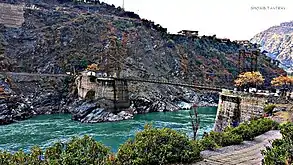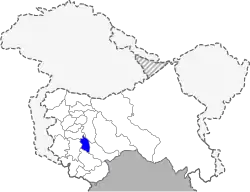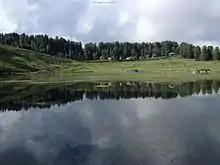Ramban district
Ramban is one of the 20 districts in the union territory of Jammu and Kashmir, India. Ramban is located in the lap of the Pir Panjal mountain range. It was carved out of the erstwhile Doda District on 1 April 2007.[3] Ramban town is the district headquarters. The town is located midway between Jammu and Srinagar along the Chenab river in Chenab Valley on National Highway-44, (originally National Highway 1A (India)) approximately 151 km from Jammu and Srinagar.[4]
Ramban district | |
|---|---|
 Old Bridge over River Chenab at Ramban | |
 Location of Ramban district in Jammu and Kashmir | |
| Coordinates (Ramban (Jammu and Kashmir)|Ramban): 33°14′24″N 75°14′24″E | |
| Country | India |
| Union Territory | Jammu and Kashmir |
| Division | Jammu Division |
| Headquarters | Ramban |
| Tehsils |
|
| Area | |
| • Total | 1,329 km2 (513 sq mi) |
| Population (2011) | |
| • Total | 283,713 |
| • Density | 210/km2 (550/sq mi) |
| • Urban | 4.16% [1] |
| Demographics | |
| • Literacy | 54.27% [2] |
| • Sex ratio | 902 |
| Time zone | UTC+05:30 (IST) |
| Vehicle registration | JK-19 |
| Major highways | NH-44 |
| Website | http://ramban.gov.in |
Administration
Ramban District is divided into eight tehsils: Banihal, Ramban, Khari, Rajgarh, Batote, Gool, Pogal Paristan (Ukhral) and Ramsoo.[5]
Each tehsil has its tehsildar, who is the administrative head. The district consisted of 116 census villages and 127 revenue villages in 2001. The total number of panchayat Halqas in the district was 124.
Geography
Ramban district is 1,156 metres (3,792 feet) above sea level (on average). The boundary lines of Ramban district encompass hill station Patnitop as its southernmost point, Assar on its eastern edge, Gool to the west, and Banihal to the north. The terrain of district Ramban is tough and hilly. District Ramban shares its boundary with Reasi, Udhampur, Doda, Anantnag and Kulgam.[3]
Climate
The climate of the District varies according to altitude. The temperature rises as high as 42 °C in the low-lying areas like Ramban town located in between steep mountains on the banks of river Chenab and drops to sub-zero in the high altitude areas like Sangaldan, Gool, Dhagantop, Asthanmarg, Lalagundi, Budhan,pogal, paristan,Neel. The working season in most of the district is about eight months because of typical weather conditions in the district.
Politics
Ramban district has three assembly constituencies: Ramban, Banihal and Gool Arnas.[6]
Demographics
Ramban district: mother-tongue of population, according to the 2011 Census.[8]
According to the 2011 census, Ramban district has a population of 283,713.[9] roughly equal to the nation of Barbados.[10] This gives it a ranking of 573rd in India (out of a total of 640).[9] The district has a population density of 213 inhabitants per square kilometre (550/sq mi) .[9] Its population growth rate over the decade 2001-2011 was 31.81%.[9] Ramban has a sex ratio of 902 females for every 1000 males,[9] and a literacy rate of 54.27%.[9]
Kashmiri, Pogali and its dialects (Sirazi) is the most widely spoken language in the district. The other languages spoken here are Urdu, Punjabi, Dogri, and Gojri. Ramban has a Muslim majority, with Muslims constituting about 63% and Hindus constituting about 28% of the population.
| Ramban district: religion, gender ratio, and % urban of population, according to the 2011 Census.[7] | |||||||||
|---|---|---|---|---|---|---|---|---|---|
| Hindu | Muslim | Christian | Sikh | Buddhist | Jain | Other | Not stated | Total | |
| Total | 81,026 | 200,516 | 414 | 753 | 43 | 3 | 252 | 706 | 283,713 |
| 28.56% | 70.68% | 0.15% | 0.27% | 0.02% | 0.00% | 0.09% | 0.25% | 100.00% | |
| Male | 43,844 | 104,078 | 253 | 427 | 24 | 2 | 132 | 372 | 149,132 |
| Female | 37,182 | 96,438 | 161 | 326 | 19 | 1 | 120 | 334 | 134,581 |
| Gender ratio (% female) | 45.9% | 48.1% | 38.9% | 43.3% | 44.2% | 33.3% | 47.6% | 47.3% | 47.4% |
| Sex ratio (no. of females per 1,000 males) |
848 | 927 | – | 763 | – | – | – | 898 | 902 |
| Urban | 5,087 | 6,224 | 70 | 405 | 1 | 1 | 1 | 22 | 11,811 |
| Rural | 75,939 | 194,292 | 344 | 348 | 42 | 2 | 251 | 684 | 271,902 |
| % Urban | 6.3% | 3.1% | 16.9% | 53.8% | 2.3% | 33.3% | 0.4% | 3.1% | 4.2% |
Ramban district
| |||
|---|---|---|---|
| Mother tongue code | Mother tongue | People | Percentage |
| 001002 | Assamese | 81 | 0.03% |
| 002007 | Bengali | 230 | 0.08% |
| 004001 | Dogri | 29,078 | 10.25% |
| 005018 | Gujarati | 127 | 0.04% |
| 006086 | Bhadrawahi | 168 | 0.06% |
| 006096 | Bharmauri/Gaddi | 2,726 | 0.96% |
| 006102 | Bhojpuri | 17 | 0.01% |
| 006125 | Bundeli/Bundel khandi | 138 | 0.05% |
| 006173 | Dhundhari | 30 | 0.01% |
| 006207 | Gojri/Gujjari/Gujar | 30,654 | 10.80% |
| 006235 | Haryanvi | 2,586 | 0.91% |
| 006240 | Hindi | 3,590 | 1.27% |
| 006376 | Magadhi/Magahi | 1,030 | 0.36% |
| 006439 | Pahari | 26,237 | 9.25% |
| 006489 | Rajasthani | 21 | 0.01% |
| 006503 | Sadan/Sadri | 18 | 0.01% |
| 007016 | Kannada | 64 | 0.02% |
| 008005 | Kashmiri | 98,570 | 34.74% |
| 008018 | Siraji | 16,853 | 5.94% |
| 008019 | Dardi | 83 | 0.03% |
| 011016 | Malayalam | 86 | 0.03% |
| 012003 | Meitei | 515 | 0.18% |
| 013071 | Marathi | 361 | 0.13% |
| 014011 | Nepali | 10,328 | 3.64% |
| 015043 | Odia | 61 | 0.02% |
| 016038 | Punjabi | 1,353 | 0.48% |
| 020027 | Tamil | 151 | 0.05% |
| 021046 | Telugu | 110 | 0.04% |
| 022015 | Urdu | 791 | 0.28% |
| 024001 | Afghani/Kabuli/Pashto | 48 | 0.02% |
| 031011 | Bauti | 25 | 0.01% |
| 053005 | Gujari | 3,923 | 1.38% |
| 055007 | Khasi | 68 | 0.02% |
| 109005 | Shina | 611 | 0.22% |
| – | Others | 52,981 | 18.67% |
| Total | 283,713 | 100.00% | |
Tourist Attractions
Sanasar

Tourist activities Sanasar include paragliding, hot air ballooning, trekking, camping, golf, rock climbing and abseiling.[11]
Tata-Pani
Tata-Pani hot spring is located near Sangaldan, Ramban.
OTHER TOURIST PLACES
- SARGALI (Pogal)
- Barhtraagan بڈ تراگن۔ and Rahoon Top (Noora Top,Pogal)
- Nani Marg (Maligam, Pogal)
- Hansraj Top And Malinsar (Pogal Paristan)
- Daggan Top (Gool)
- Chamsar Top (Ramban)
- Shinkli Top (Ramban)
- Ranjati (Gool)
- Ramakunda (Gool)
- Tanj Maidan (Banihal)
- Zaban (Banihal)
- Brahru (Ramban)
- Shainshi (Ramban)
- Shirthtathi (Banihal)
- The Hill station of Nowgam Valley North Banihal
- Origin of Bishliri Nallah
- Historical Sheep breeding farm (1932) is situated at Zaban
- Sanasar (Ramban)
- Sunasari (Pogal)
- Shakhpal Hill (Ramban)
- Thandichowa (Banihal)
- Mahu,Mangit (Khari)
- Sharva dhar(hills) (Pogal)
- Bajkote (Rajgarh)
- Jhat Gali
- Neel Top and Waasaw Marg (Neel)
- Patnitop. One of the most famous picnic spots of Jammu Region.
Major projects
See also
References
- Census of India 2011
- "Ramban District Population, Caste, Religion Data (Jammu and Kashmir) - Census 2011".
- - About Ramban
- Statement showing the number of blocks in respect of 22 Districts of Jammu and Kashmir State including newly Created Districts Archived 2008-09-10 at the Wayback Machine dated 2008-03-13, accessed 2008-08-30
- "District Profile". District Administration, Ramban. Indian Government. Retrieved 15 September 2017.
- "ERO's and AERO's". Chief Electoral Officer, Jammu and Kashmir. Archived from the original on 22 October 2008. Retrieved 28 August 2008.
- C-1 Population By Religious Community – Jammu & Kashmir (Report). Office of the Registrar General & Census Commissioner, India. Retrieved 28 July 2020.
- C-16 Population By Mother Tongue – Jammu & Kashmir (Report). Office of the Registrar General & Census Commissioner, India. Retrieved 18 July 2020.
- "District Census 2011". Census2011.co.in. 2011. Retrieved 30 September 2011.
- US Directorate of Intelligence. "Country Comparison:Population". Retrieved 1 October 2011.
Barbados 286,705 July 2011 est.
- "Sanasar Sightseeing, Places To Visit In Sanasar, Things To Do In Sanasar". www.holidify.com. Retrieved 18 January 2017.